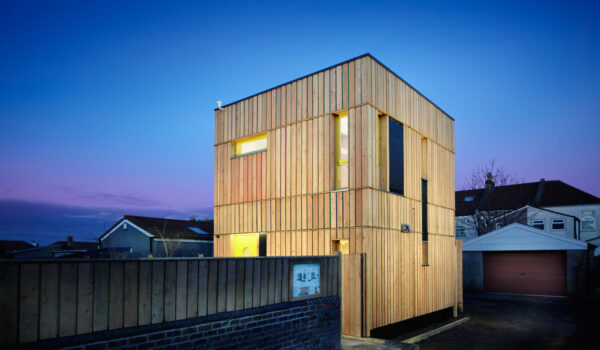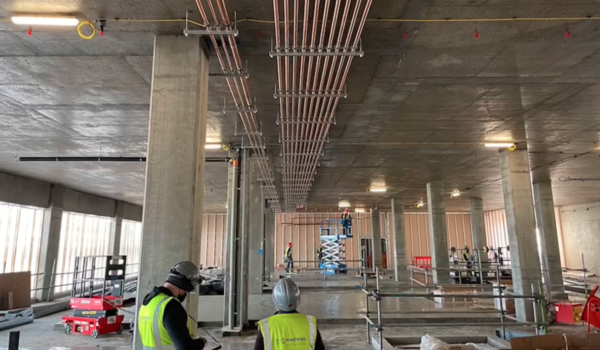The UK construction industry’s harmful impact on the environment is well documented, with plastics and synthetic materials at the forefront of the damage.
In the fight against the plastics greenwash across the industry, housing and care provider, GreenSquareAccord, has successfully completed the build of virtually plastic-free homes. The project demonstrated the ‘art of the possible’ in living plastic-free and provided learnings to inspire future developments.
The first of its kind in Europe, the CHARM (Circular Housing Asset Renovation & Management) project saw the construction of a block of 12 one-bedroom flats in a former factory car park in Redditch.
Owned and built by GreenSquareAccord and developed through collaboration with Redditch Borough Council, the ground-breaking property is part of the CHARM partnership, made up of representatives from four European countries: the UK, France, Belgium and the Netherlands.
Now complete, the apartments are managed by Redditch Cooperative Homes.
Planning the project
The homes incorporated 125 tonnes of recycled materials into the construction of the block, saving these materials from being landfilled. Alongside wide recycling use, another key element to the sustainable construction project included reducing the amount of materials used in the build.
What many of us don’t realise, is just how much plastic usage goes into building a house or developing a property. Thanks to resourceful planning, the CHARM development saves 65 tonnes per dwelling of material use.
While it is impossible to achieve a fully plastic-free construction project in this current climate, the CHARM property used 85% less plastic in its construction compared to usual projects of its size.
Due to the innovative materials used, and labour involved, the costs of the development were significantly higher than those of a ‘standard’ development. However, we have no choice but to continue to innovate construction materials and methods to advance progress in the sector, in turn, making developments of this kind more affordable over the long term.
Swapping the synthetics
By making many thoughtful substitutions away from plastic, the CHARM project has set the standard for future construction projects.
The shell of the property was built from timber panels from GreenSquareAccord’s award-winning, low-carbon manufacturing facility, LoCaL Homes.
The pipes in the development, that would traditionally be made of plastic, were replaced with copper, providing all twelve flats with water. Each boiler has also been fitted with copper pipes to heat the flats. Electrical copper wiring was also used in the dozen flats, showcasing the material’s versatility
As one of the most sustainable materials in construction, copper is infinitely recyclable, meaning it can be used over and over without any loss in performance or properties. In fact, at least 65% of all copper mined remains in circulation — and around half of Europe’s copper demand is currently being met by other recycled materials.
Instead of plastic cladding, the CHARM properties feature cementitious board. The board contains minimal traces of plastic as a binding agent, unfortunately exemplifying the impossibility of an entirely plastic-free project. Despite originally intending to install timber as a cladding material, planners elected cementitious boards instead in order to make the building as fire safe as possible.
Plastic need was also eliminated in the bathroom, being replaced by ceramics, while timber was used to create kitchen units. Where plastic is typically present in window frames, the CHARM project installed aluminium instead.
Other swaps in the build to reduce synthetic materials include mineral-insulated copper cable in the internal electrical power circuits, foam glass floor insulation, flooring using sisal and linoleum, and copper pipework with welded joints.
Unavoidable plastics
Throughout the period of the development construction, some surprising materials were found to contain plastic. These included paint, sealant, and insulation, meaning alternative options had to be sourced. Developers identified plastic-free paints using natural ingredients like graphene and lime paint.
The CHARM team had to make some other compromises in the material choices. For example, plastic intumescent strips had to be installed to ensure fire safety. What’s more, utility companies offer standard meters without a plastic-free option. Despite these setbacks, the project still managed to save 65 tonnes of material per residence.
The benefits of the project
The CHARM project not only created 12 affordable homes for members of the community, but it also reduced the environmental impact of the construction.
Setting a new standard and ‘art of the possible’ example of sustainability for the construction sector is critical given the industry’s role in plastic pollution.
In the UK, the construction industry accounts for 19% of all plastic waste across the UK, which is the equivalent to approximately 50,000 tonnes, or five times the weight of the Eiffel Tower.
Of the 50,000 tonnes, it’s estimated that 20,000 tonnes are sent straight to landfill to be incinerated, releasing toxic fumes and carbon emissions.
A look to the future
Could developments like the CHARM project indicate the future of construction? The answer is simple, yes. Reducing plastic waste by the mass is of critical importance and the CHARM project is paving the way for future construction projects.
After being recognised for its potential, the project received £1.2m EU funding from the Interreg North-West Europe funding partnership, opening the way for future projects and development.
Now, the United Nations is aiming to sign an agreement which would see the elimination of plastic pollution with legally binding enforcement. Under this directive, it’s likely projects such as CHARM virtually plastic-free homes, would become increasingly present in our modern world.
Reducing plastic and synthetic materials in building projects and replacing them with more sustainable options, such as copper, is the only future of the construction industry.

